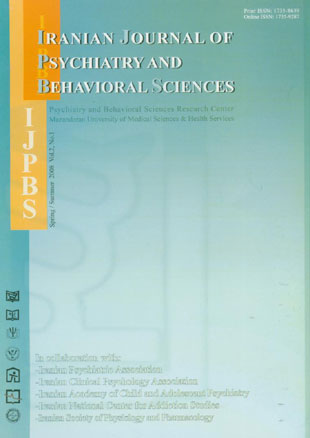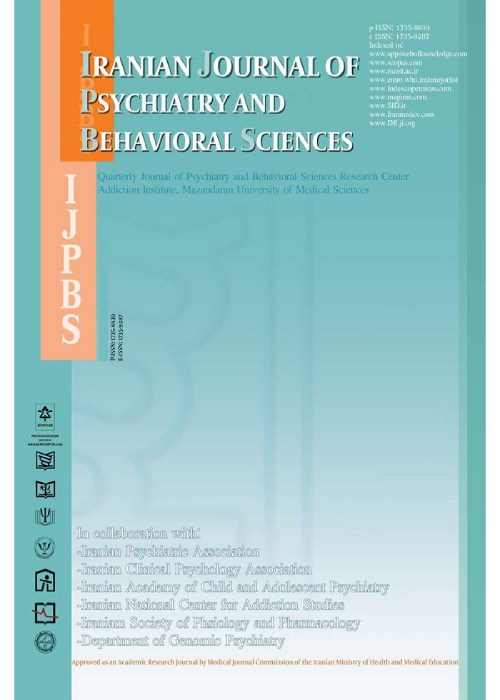فهرست مطالب

Iranian Journal of Psychiatry and Behavioral Sciences
Volume:2 Issue: 1, Jul 2008
- تاریخ انتشار: 1387/02/11
- تعداد عناوین: 16
-
-
EditorialPage 1
-
Page 4The molecular mechanisms of the fact that more than 50% of the individuals with the same genetic make up (e.g. identical twins in schizophrenia) do not show the same psychiatric phenotype remained undefined in psychiatry. This along with the failure to find responsible genes with major effects in psychiatric disorders and lack of consistency of genetic association studies led to the current unanimous conclusion that, in addition to the genetic factors, environmental and epigenetic factors influence the functions of brain and the presentation of the symptoms in mental diseases. Here we reviewed the potential epigenetic dysregulations of genes related to dopaminergic (DAergic) system. A comprehensive genetic and epigenetic analysis of the DAergic and the interacting pathways such as serotoninergic and glutaminergic systems could help to understand the molecular bases of the differences in disease severity in individuals with similar or identical genetic make-up that can assist for the identification of novel targets with therapeutic and preventive applications.
-
Page 14ObjectiveThe current study was performed to evaluate the cognitive improvements of the chronic schizophrenic patients treated with risperidone in comparison with those treated with haloperidol according to Wisconsin Card Sorting Test (WCST).MethodsIn a double blind clinical trial, 65 patients with a diagnosis of chronic schizophrenia were randomly allocated into two groups. They received a 7 days washout and then during an eight weeks period one group was treated with risperidone 4-8 mg daily while patients in the other group received haloperidol 10-15 mg daily. Patients of the two groups were assessed by positive and Negative Syndrome Scale (PANSS) and Brief Psychiatric Rating Scale (BPRS). Patients’ cognitive abilities were assessed by WCST. Treatment side effects were also evaluated in both groups.ResultsThe overall PANSS score, the scores of the positive and negative subscales and BPRS scores revealed that risperidone was significantly superior to haloperidol in the treatment of psychotic symptoms (p<0.001). Risperidone caused less marked dyskinetic side effects in comparison with halopridol (p<0.001). Haloperidol produced more symptoms of parkinsonism and tardive dykinesa than risperidone. The positive cognitive effect of risperidone was significantly better than haloperidol at 4th (p<0.001) and 8th (p<0.001) weeks.ConclusionApart from being more effective in improving positive and negative symptoms of psychotic disorders, risperidone is also more beneficial in reducing the symptoms of cognitive impairment in chronic and long standing form of schizophrenia. It also seems to be better tolerated than haloperidol
-
Page 21ObjectivePatients with conversion disorder may be seen by different specialists in various clinics and emergency situations. However, there are not sufficient studies on the most effective treatment for this disabling illness.MethodsIn a clinical trial, we compared four treatment strategies; muscle relaxation, suggestion, hypnosis and intravenous diazepam infusion, in 80 patients with acute conversion disorder. Speed of recovery and number of the recurrences in a month following different treatment options were compared among groups.ResultsRecovery was significantly quicker with muscle relaxation compared to hypnosis and diazepam infusion. In patients with comorbidity of major depressive disorder, recovery was even faster. There was no statistically significant differences in the number of remissions or relapses among the four groups.ConclusionAll the four different treatment strategies brought about significant recovery. However, after treating patients with muscle relaxation, recovery was faster compared to other treatment methods.Iranian Journal of Psychiatry and Behavioral Sciences (IJPBS), Volume 2, Number 1, Spring and Summer 2008: 21-25
-
Page 26ObjectiveAntisocial, aggressive and delinquent behaviors in adults often begin early in life. Basal cortisol is a valuable biological marker in children with disruptive behavior disorder (DBD). To investigate the association between biological factor (cortisol) and disruptive behaviors, we studied the effect of family training on salivary cortisol level in children with DBD.MethodsBasal salivary cortisol levels were studied in 19 children with DBD, (aged 8 -13 years old) prior and 2 months after the treatment. The disruptive behavior of the child was also assessed by Child Behavior Checklist (CBCL), before and 2 months after treatment.ResultsChildren with lower basal cortisol level had more sever behavioral problems. Surprisingly, this group had a better response to family therapy.ConclusionParental training is an effective method for behavioral modification of children with DBD. Salivary cortisol can be considered as a biological marker for the severity of disruptive behavior and response to therapy.
-
Page 31ObjectiveSpouse abuse is a major worldwide health concern and includes a wide range of emotional, physical and sexual maltreatments. The objective of present study was to determine the prevalence and risk factors of spouse abuse among women who were registered with health centers in the city of Sari.MethodsWe distributed two specifically designed questionnaires among one thousand women whose name was in the list of health centers register in Sari. The subjects had been randomly selected from a list of 49330 registered women. Demographic data and data on spouse abuse were then analyzed by using Student’s unpaired t-test and Chi- square test.ResultsIncluding mild forms of abuse, 73.5%, 92.2% and 49.6% of women reported that they were subjected to physical, emotional and sexual abuse respectively at least once during their lives. This figure was 3%, 10.4% and 5.8% for moderate forms, and 0.5%, 1% and 2.2% for severe forms of abuse. Younger age, un- employment, low level of education, substance misuse, presence of a physical or a psychological problem and having more children were risk factors for domestic violence.ConclusionThe study revealed a high prevalence, especially mild forms of domestic maltreatment in the sample population. The type and risk factors of domestic violence seems to be similar throughout the world irrespective of differences in cultural and religious backgrounds. Authors believe that addressing unemployment, substance misuse problems and early treatment of mental illness in young couples in Iran will reduce the risk of domestic violence.
-
Page 36ObjectiveAs domestic violence becomes increasingly recognized a widespread social problem, judicial system has begun playing larger roles in providing legal protection to these victims. One way they are doing this in the United States is through the use of protective restraining orders or injunctions. The purpose of this research was to determine if permanent Injunctions for Protection provide victims of Domestic Violence with a sense of security in alleviating fear of retaliation or on-going violence.MethodsA total of 196 permanent injunctions for protection against domestic violence were obtained by victims residing within the City of Lakeland Florida. The survey consisted of telephone interviews with 51 domestic violence victims whom were selected randomly.ResultsAbout eighty six percent of victims reported feeling safe, 90% said they felt better emotionally and 86.36% indicated that their life had improved after the injunction was ordered.ConclusionThe respondents of the interviews felt that the permanent injunctions were beneficial to their feelings of safety and general well being, as well as being worthwhile.
-
Page 43ObjectiveErroneous beliefs about causation and lack of adequate knowledge have been found to sustain deep seated negative attitudes about mental illness. Conversely, better knowledge results in improved attitudes towards people with mental illness and a belief that mental illnesses are treatable can encourage early treatment seeking and promote better outcomes. The aim of this study was to assess the awareness of the etiology of mental illness among the caregivers and to determine their knowledge on the treatment possibilities.MethodsA cross sectional study of all consenting consecutive caregivers of mentally ill patients attending the in-, and out-patients psychiatric facilities of University Teaching Hospital, Ilorin, Nigeria was done, using a questionnaire method.ResultsThree hundred and ninety-four respondents were recruited for the study. The mean age of the respondents was 38.84 ± 14.64. Majority (244 or 61.9%) of the respondents believed drug and alcohol misuse could cause mental illness, while the belief that it could be due to ‘curse’ were reported by only 75 (19.0%) respondents. Male gender was associated with belief that alcohol and drug misuse, stress, genetic inheritance, physical illness, and poverty were causes of mental illnesses(p<0.05). Higher educational status was also associated with alcohol and drug, traumatic events, stress, genetic inheritance, and physical abuse (p<0.05) as causes of mental illness.ConclusionThere is a better knowledge of mental illness among caregivers than the predominant supernatural causes earlier attributed to mental illness by Nigerian communities. In order to sustain this, there is need for psycho-education.
-
Page 50Despite advances in antiviral therapy over the past 2 decades, herpes simplex encephalitis (HSE) remains a serious illness with significant risk of morbidity and mortality. HSE includes a range of clinical presentations, from aseptic meningitis and fever to a severe rapidly progressive form with mental status changes (clouding of consciousness, confusion, disorientation, personality changes) and sometimes seizures (focal or generalized), dysphagia, or other focal neurological signs. Symptoms vary in intensity early in the disease, but tend to progress rapidly. Brain CT Scan and MRI can play an important role in determining the diagnosis and extent of the disease. This case report refers to an 8-year-old girl, diagnosed with herpes encephalitis that presented with seizure, bloody diarrhea and decreased level of consciousness and restlessness who recovered clinically after acyclovir treatment
-
Page 54Buprenorphine (Subutex) has been used to treat opioid dependency in the past 16 years. Subutex (or buprenorphine hydrochloride) was approved by the Singapore''s Ministry of Health (MOH) in 2000 as a substitution treatment for opiate-dependent drug abusers within the framework of medical, social and psychological treatments. It was subsequently introduced into the Singapore market in 2002. In spite of the promise of improvement in the lives of addicts with medical care, a distinct trend of buprenorphine abuse has occurred. A cascade of events from 2002 to 2006 led to discontinuation of Subutex treatment programs in the country. In this paper, firstly reports on morbidity and mortality caused by Subutex IV abuse will be reviewed and secondly, the MOH response to the situation will be outlined and finally, implications of Singapore’s experience with Subutex will be discussed.
-
Iranian mental health related instritutionsPage 60
-
Recent events in iranian psychiatry and Allied SciencesPage 61
-
Profile of the iranian Experts in the field of psychiatry and Behavioral sciencesPage 63
-
Excent from persian psychiatric and behavioral sciences litteraturePage 65
-
CalendarPage 74
-
International congress of traditional and complementary medicinePage 75


